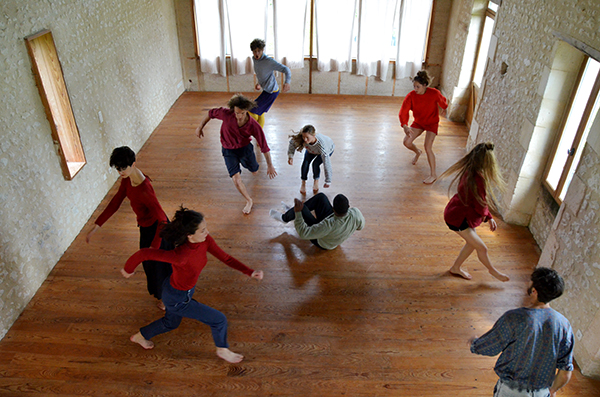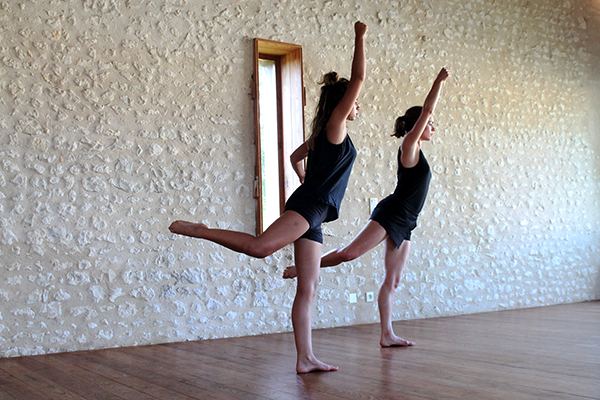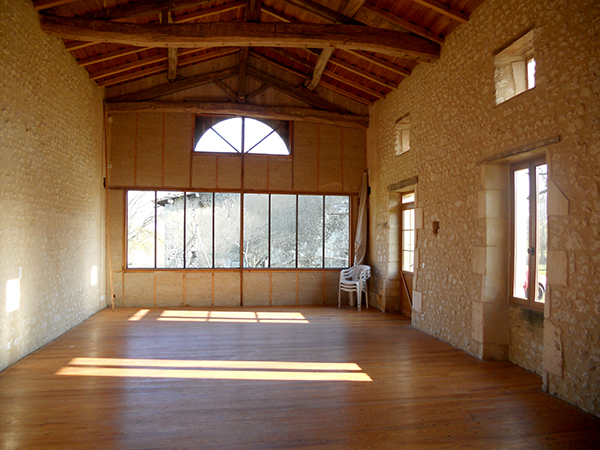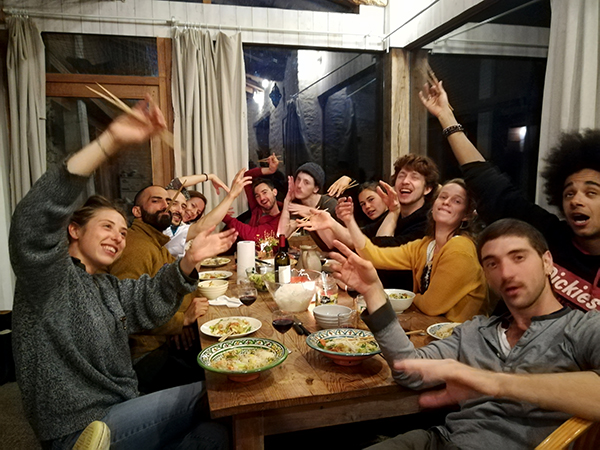Outside Institutions
An Interview with Patricia Chen
BY EMMALY WIEDERHOLT
Patricia Chen is a dancer, teacher and choreographer living in Bordeaux, France. After a career in New York, she found herself in France, slowly building her own dance practice, creating her company – Chendance – and building her studio in the countryside – Oakspace. She tells her story and contrasts her experience in Bordeaux with New York.
This interview is part of Where Dance Is, a series of interviews with dance artists working outside major metropolitan centers.
Photo by Pauline Jasson
~~
Tell me a little about your history and how you came to be based in Bordeaux.
I danced in New York from 1980 to 1993. There was a whole population of us who weren’t dancing in big companies, but who were performing in a variety of venues around town. I danced with maybe 13 different smaller companies. I was always paid for dancing, but never with one big company that paid me a salary. I always had a side job word processing for a lawyer or for engineers, as well as accompanying ballet classes (I’m also a classical pianist). My dance classes were covered by scholarships, so I had to be in the studio every day. It was a precarious existence where I had to keep it all going in order to keep it all going.
Through my roommate, who was also a dancer and whose side job was working in French restaurants, I met a French chef. We started going out, and it became a long on-and-off love story and friendship. Whenever I had a break, I used to go to Paris. At one point, I had ostensibly quit dancing and decided to go to medical school. My French friend/lover proposed to me and said, “Why don’t you move to France, so we can finally be together and start a family?” He told me I could go to medical school in France. We got married in New York and moved to Bordeaux. He had a restaurant on the Bassin d’Arcachon, a beautiful bay close to Bordeaux. I had plans of going to medical school, as my prerequisites were all completed, but by the time school started, I had a baby.
It was hard to be a new mother and be in medical school, and I didn’t last very long. I started looking for a job, and discovered that all the jobs for Americans in Bordeaux were teaching English. I didn’t even try to pursue dance; I had quit dancing in my mind. The first job I got was teaching English at an international school. Later, I ended up with a fulltime job teaching English at the School of Fine Arts in Bordeaux (ebabx) and the Conservatory of Bordeaux. At the conservatory, I was primarily working with actors. I started teaching English through dance – I would make movement phrases using chance operations, picking elements randomly out of a stack. This way, my students learned body parts, verbs and adverbs.
After a while, I got a bit of a following. Many of my student actors wanted to keep working with me. One particular class had been studying with me for three years and, when they graduated, wanted to keep studying. At that point, I found a space and started an open workshop where once or twice a month on weekends, all these actors from the conservatory, as well as sculptors and painters from the fine arts school, would come take my workshops.
I was in residency in the space for three years, and people who were interested would come work with me. We did all kinds of experiments. My daughter was still little at the time, and by then I was a single mom, so she would play in our apartment, which was next door upstairs, while I taught downstairs. Sometimes she and her friends would participate.
Eventually, my students asked to show what they were doing, so we organized a performance. Because we had worked on different forms each weekend, the show became a suite of little movements. But since it had been over a period of three years, it ended up being a huge piece. We named it “Tribe,” and we called the group Chendance. From there, we were invited to perform at a festival. We also put together a film version.
Since then, there have been four iterations of Chendance. Some groups have had six or seven members, while others have had only four. They come from various backgrounds in the arts, but I primarily choose them for their minds. They don’t pay me, and I don’t pay them. It’s more of an exchange. I develop my work with and on them and, if I get opportunities for them to perform, I pay them a small stipend or a one-time fee. However, they all leave Bordeaux at some point to pursue their own artistic careers, as there aren’t a lot of other opportunities here. That’s why there have been four iterations of the company. It’s like a creative family that takes a life of its own.
There’s also a larger group of people in Bordeaux and surrounding area who take my workshops when they are offered, and some of those people pay a reasonable fee. The ones who can’t pay help me with the cooking or work on the place in exchange. My workshops now take place in my space in Charente-Maritime, outside Bordeaux. Sometimes the workshops are for kids or for people who don’t have artistic backgrounds.
Tell me a little about your current space.
One of my best friends had a sprawling house in the country in Charente-Maritime with only a few rooms fixed up. Our kids are close, so we used to spend a lot of time together there on the weekends. At some point, she suggested I buy something in the area.
My parents had bought me an apartment in New York when I lived there and, when they sold it, after paying for my studies at NYU, I used the money to buy three acres of land and the two 200-year-old ruins on it. It’s located one-hour northeast of Bordeaux in a town called Sousmoulins. I turned it into my own studio, called Oakspace.
Now, it’s open for residencies beyond my own work. People have come from as far as New York, Florida, Tel Aviv, Milan or Berlin. I also invite people who I’ve met or who I used to dance with to teach workshops. It’s also, of course, where Chendance rehearses and where I teach.
How would you describe the local dance scene where you live?
The most interesting thing going on, in my opinion, is the local hip hop scene. I was in New York when hip hop was first developing. Here in Europe, it’s become almost a vocabulary of its own. I feel it’s a very rich and creative thing happening in Bordeaux. There are two established hip hop companies now that are getting grants and touring. The rest of the hip hop scene is operating through non-profit associations, and people come here from all over France to do battles.
What takes about 25 percent of the budget available to support all the arts in Bordeaux is the opera. Bordeaux is a bourgeois town with old families who made their money in wine and slave ships. It’s the dirty secret of Bordeaux. The problem is that the people here get their culture by going to the opera and ballet. They have their subscription. When they decide to find something more modern, they go to the National Theater, where they might see some more avantgarde stuff.
There are a few smaller theaters within an hour of Bordeaux as well. If you want to see good dance in Bordeaux, you can organize yourself to see some cutting-edge stuff. But there’s no dance population that stays here when they finish school because there are almost no open professional-level classes.
What are the advantages and disadvantages of being a dance artist in Bordeaux?
The benefit is that no one cares what I’m doing. I have total creative freedom. I am basically subsidizing myself, and I have a free space. I have access to people who are really excited to work with me.
When I left New York, I felt like I knew everybody, and everybody knew me. I had danced for choreographers who gave dancers a lot of responsibility in the creative process, so the step from dancer to choreographer was quite easy. I started doing solos on myself when I was in New York. I did solos because I couldn’t pay anybody to work with me, and renting space was already so expensive. I made a couple of solos and showed them, and a lot of people really encouraged me. But when I ran into people I knew, they always wanted to know what my next project was, or when I was going to perform or choreograph next. I felt blocked by all that pressure.
When I moved to Bordeaux and quit dancing, nobody cared or even knew I had been a dancer. They just knew me as “Lani’s mom.” It was extremely freeing and, when I started to incorporate dance into my English classes, nobody really paid attention. It was truly experimental with no economic justifications.
The drawback is that I’m not legitimate in the eyes of the local schools and institutions. France is very attached to its institutions. It’s for a good reason – students in France can get a music, dance or theater education for basically free, assuming they get accepted to the state-sponsored schools, but those are understandably the people who are supported professionally, since public funds have already been invested in their education.
I have French citizenship, but I would never get funding or grant money. They don’t know what to do with someone like me. They have to support the population that went through their system. I’m independent, especially since I have my own space. I get performance opportunities through friends and associations
The other problem is that there are private studios for kids and amateur adults, but no open classes for professional level dancers. So even though there are some good schools in the area, the dancers that come out of them tend to leave. The opera ballet company is not open for class either. There’s one guy in Bordeaux – his company is called Lullaby – and he teaches a three-hour class that consists of floor barre, ballet class and hip hop. I used to take the first two parts of his class.
There used to be the Center for Choreographic Development. It was a little out of Bordeaux, and they had great programs and concerts, as well as a professional class once a week. That was where I met a lot of the dancers and teachers I know here. But they lost their space and have just recently taken over another space. I’m waiting to see what they will do next.
Everyone here is kind of hanging on, looking for space, looking for students, trying to get performance opportunities, and all the decisions here are political. Our mayor is not very up on culture, and his culture team makes decisions to give most of the money to the big institutions. All the little companies and theaters are barely making it.
There used to be a status called “intermittent.” It was based on the understanding that if you’re a performer, you are working on your craft for many hours beyond performances, so if you did at least 25 performances a year, you could receive unemployment between gigs. It kept everyone going. But under Sarkozy, the status became almost impossible to get. Now you must have more gigs over a shorter period, so independent performing artists can’t get that unemployment insurance. It’s really hard to be a freelancer here.
What do you perceive is your influence on your community?
I’m offering workshops and a professional atmosphere that few others outside of the institutions here are. Through my contacts and relationships, I have built an international experimental space. It’s a form of cultural exchange that brings in totally different styles and personalities and offers rich experiences. I’m feeding a population that wouldn’t normally have that access to emerging or cross-disciplinary artists.
There’s a whole philosophy to my company and workshops. We cook and eat together in addition to dancing together. We shoot videos in the fields and forests around the house. We dance with the horses. We make our own music and sometimes it grows out of our discussions around the table, for example. What I do hooks people up to work together in the future. Projects grow out of what happens in my space in very unexpected ways. It’s a safe and supportive environment. I try to strip away the distractions of competition or judgment. I provide a first step for young artists coming out of the schools. They discover what a kind of “artistic family” atmosphere is all about. What I create is what the people who come and work with me carry away with them.
Photo taken at a meal during a Gaga workshop w/ Tom Weinberger at Oakspace
~~
For more information, visit chenoakspace.wixsite.com/chendance and the Chendance Facebook page.





6 Responses to “Outside Institutions”
Thanks Eva!
Indeed Holly! Thanks for reading and commenting! People like Patricia are oh so important to have in the world!
What an inspiring interview on so many levels! Reading Patricia Chen’s words describing the varied, inescapable and remarkable trajectory of her life and artistic career makes me feel quite humble. It’s clear she is a true, abiding artist, and she shows by example that when it comes to finding an outlet for an organically brilliant and inescapable gift of creativity that someone like her she possesses, an artist will find a way. In this day and age, I sometimes feel close to despair about the state of the arts in society, but it is so heartening to read about someone like Patricia — a pure and giving artist, and clearly dedicated to nurturing not only her own creative destiny, but to helping others pursue their passions for dance and art and movement and the choreographic process. She is an international treasure and a beacon of light, and it’s wonderful that ‘Where Dance is’ is focusing on unsung artistic heroes like her.
What a wonderful interview!
I couldn’t agree more! Thanks for reading and sharing your thoughts, Misa!
This is such a beautiful article! I so believe in life outside of institutions for the creative life, and for me, this is where the the most refreshing creative expressions exist with the greatest degree of compassion and empathy towards all who dare to be true to their passions as dancers and dance makers. Also, a high degree of poetry and integrity because one can be true to their own vision with no need to conform to the existing paradigm. One can create the container one believe best suits the moment, and this container can grow and evolve as one grows and evolves as an artist. Awesome share! Thanks! Misa
Comments are closed.